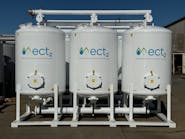There is currently a great deal of activity surrounding the removal of the group of contaminants broadly referred to as per- and polyfluoroalkyl substances (or PFAS) from drinking water. Several states have adopted Maximum Contaminant Levels (MCLs) and the industry is anticipating a proposed Federal MCL drinking water standard for perfluorooctanoic acid (PFOA) and perfluorooctane sulfonic acid (PFOS) in the fall of 2022. The MCLs that individual states have established vary, but the more stringent limits are not seeking to narrow the levels of PFAS in water to the parts per million (ppm) or parts per billion (ppb), but to less than 10 parts per trillion.
So, just how much is a part per trillion? To get an understanding of just how small one part per trillion really is, we first need to grasp the vast size of the cardinal number trillion.
Let’s consider one trillion dollars. If you are a billionaire, and you have 1,000 billionaire friends, then all of you together have a trillion dollars. Note that there aren’t currently any trillionaires in existence. A trillion dollars would be an incredible amount of money. In fact, it’s almost all of the money in the nation; there is approximately $1.2 trillion of U.S. currency in circulation. One trillion dollars would buy about 22 million new cars, or all of the gasoline sold in the U.S. for 8 years, or the entire Tesla company.
Let’s imagine the amount of time in one trillion seconds. A billion seconds ago it was 1990; a trillion seconds ago it was 29,700 B.C. When you are 31 years and 8 months old, you have lived about a billion seconds. You would have to be 31,709 years old to live a trillion seconds.
So, we can see that a trillion of something is an enormous amount. Now let’s focus on one part per trillion, and what an incredibly small concentration that is. In those 31,709 years of your lifetime, when we are looking for 1 part per trillion, that would be one second of your life. One part per trillion is literally the blink of an eye.
For the scientific and mathematic minded,
- One part per million = 1 ppm = 0.0000001 = 1 x 10-6 = 1 milligram per liter = 1 mg/L
- One part per billion = 1 ppb = 0.000000001 = 1 x 10-9 = 1 microgram per liter = 1µg/L
- One part per trillion = 1 ppt = 0.0000000001 = 1 x 10-12 = 1 nanogram per liter = 1 ng/L
The ability to comply with these stringent levels is challenging. From proper sample collection techniques to accurate analytical measurement, to reliable full-scale treatment processes. However, all of these are available and in use today.
The treatment processes for consistent and reliable reduction of many of the PFAS contaminants under scrutiny to the ppt levels not only exist today but are in operation and delivering compliant water on a consistent, reliable basis.
Federal regulation of drinking water quality began in 1914 in the United States, just over a hundred years ago. Today, the EPA sets legal limits for more than 90 contaminants in drinking water. As technology advances, the ability to detect, measure, and remove contaminants from drinking water will continue to evolve. Although the term parts per trillion is relatively new in our discussions today, perhaps it will become common lingo in the very near future. WW
About the Author: Ron Dollar is the senior vice president of sales and marketing for Water Remediation Technology (WRT), and a member of the Water and Wastewater Equipment Manufacturers Association (WWEMA). He also serves as chair of the marketing and member services committee of WWEMA and is a member of the Board of Directors. WWEMA is a non-profit trade association formed in 1908 to represent water and wastewater technology manufacturers and related service providers. WWEMA is made up of many of the most prominent and influential companies in the industry who are working together to shape the future of water and wastewater technology in the U.S. and around the world. For more information about WWEMA, visit www.wwema.org.
Published in WaterWorld magazine, May 2022.



